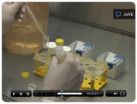(Press-News.org) Macrophages playing an important role in the immune system eat and fight against pathogens and foreign substances in the very beginning of infection. In this condition, macrophages produce reactive oxygen species for sterilization. However, the relation with the temperature sensor was not previously known. Professor Makoto TOMINAGA from National Institute for Physiological Sciences (Okazaki Institute for Integrative Bioscience), National Institutes of Natural Sciences, and his research team member Ms. Makiko KASHIO have identified the mechanism through which TRPM2 is activated by body temperature with hydrogen peroxide (a kind of reactive oxygen species) produced by immune reactions. This research result was reported (online in the week of 9th April, 2012) by Proceedings of the National Academy of Sciences of the United States of America.
The research group focused on the relation between hydrogen peroxide and TRPM2. Although TRPM2 is usually activated by high temperature near 48oC in the absence of endogenous ligands, it becomes activated at our normal body temperature with hydrogen peroxide production. It means that hydrogen peroxide works as "a switch" which controls TRPM2 function. In addition, they found that phagocytic activity of macrophages was enhanced in the febrile temperature (38.5℃). Professor TOMINAGA says, "It was also revealed that oxidation of TRPM2 by hydrogen peroxide is involved in the switch-on mechanism and we identified a single amino acid which is oxidized. This newly identified mechanism of TRPM2 regulation may lead to the development of new treatment strategies or drugs for infection. When we are infected with bacteria, we often run a fever, and it is known that body temperature might be important for our immune system. TRPM2 might explain the mechanism through which fever boosts up our immune system. "
###This result was supported by Grant-in-Aid for Scientific Research from the MEXT, Japan.
Immune cells, 'macrophages' become activated by body temperature
Molecular mechanisms involved in the switch-on of the temperature sensor TRPM2 by hydrogen peroxide have been clarified
2012-04-10
ELSE PRESS RELEASES FROM THIS DATE:
Penn study cautions use of drugs to block 'niacin flush'
2012-04-10
PHILADELPHIA — Niacin, or vitamin B3, is the one approved drug that elevates "good" cholesterol (high density lipoprotein, HDL) while depressing "bad" cholesterol (low density lipoprotein , LDL), and has thereby attracted much attention from patients and physicians. Niacin keeps fat from breaking down, and so obstructs the availability of LDL building blocks.
Patients often stop taking niacin because it causes uncomfortable facial flushing, an effect caused by the release of a fat called prostaglandin or (PG)D2. PGD2 is the primary cause of the unwanted vasodilation, ...
23andMe identifies 5 significant genetic associations for hypothyroidism
2012-04-10
MOUNTAIN VIEW, CA – (April 6, 2012) – Using its unique online research platform, 23andMe, a leading personal genetics company, has found five significant genetic associations for hypothyroidism in the largest known genome-wide association study of hypothyroidism conducted to date. The details of the study are now available online in the journal PLoS ONE.
"With nearly 90 percent of our 125,000 customers participating in our online research, 23andMe is making crowd-sourced science a reality," stated 23andMe CEO and co-founder Anne Wojcicki. "Our online research platform ...
Researcher finds faster, cheaper way to cool electronic devices
2012-04-10
A North Carolina State University researcher has developed a more efficient, less expensive way of cooling electronic devices – particularly devices that generate a lot of heat, such as lasers and power devices.
The technique uses a "heat spreader" made of a copper-graphene composite, which is attached to the electronic device using an indium-graphene interface film "Both the copper-graphene and indium-graphene have higher thermal conductivity, allowing the device to cool efficiently," says Dr. Jag Kasichainula, an associate professor of materials science and engineering ...
New poll shows New York voters support global health research but unsure where it is conducted
2012-04-10
WASHINGTON—April 9, 2012— New York voters recognize the importance of global health research and are concerned about the United States' ability to compete globally, according to a new poll commissioned by Research!America, yet an overwhelming majority (93%) of those polled don't know where global health research is conducted in their own state.
The majority of New Yorkers (64%) think that New York residents should be concerned about global health and an additional 63% believe that spending money on global health is important to their state's economy. However, poll results ...
'Nanobubbles' plus chemotherapy equals single-cell cancer targeting
2012-04-10
HOUSTON -- (April 9, 2012) -- Using light-harvesting nanoparticles to convert laser energy into "plasmonic nanobubbles," researchers at Rice University, the University of Texas MD Anderson Cancer Center and Baylor College of Medicine (BCM) are developing new methods to inject drugs and genetic payloads directly into cancer cells. In tests on drug-resistant cancer cells, the researchers found that delivering chemotherapy drugs with nanobubbles was up to 30 times more deadly to cancer cells than traditional drug treatment and required less than one-tenth the clinical dose.
"We ...
Researchers identify genes that may help in ovarian cancer diagnosis and prognosis
2012-04-10
Philadelphia, PA, April 9, 2012 – Scientists from Duke University Medical Center have determined that genes acting as molecular "on/off" switches can define clinically relevant molecular subtypes of ovarian cancer, providing ideal potential targets for use in clinical prognostic and diagnostic testing. These bimodal genes can define tumor subtypes that have different overall prognoses and respond to different therapeutic regimens. The researchers' results are published in the May issue of The Journal of Molecular Diagnostics.
"We identified a very small set of genes ...
A better tool to diagnose tuberculosis
2012-04-10
Up to 30% of the world's population is infected with Tuberculosis (TB), but in many areas of the world, TB diagnosis still relies on insensitive, poorly standardized, and time-consuming methods. A new diagnostic tool, endorsed by the World Health Organization (WHO), may change that. Dr. Thomas Bodmer shows how it's done in the Journal of Visualized Experiments (JoVE).
Currently, TB is diagnosed through either a skin test, which produces a small bump on the patient's arm when administered and needs to be checked after 72 hours, and through smear microscopy, a method that ...
WirelessTimeClock.com Launches Redesigned Site
2012-04-10
WirelessTimeClock.com, a trusted source for web-based time clocks, has re-launched its website (http://www.wirelesstimeclock.com) with a more intuitive and streamlined design, promising a more enriching experience for businesses searching for reliable employee time clocks and time and attendance management solutions.
"Our customers have been asking for a more intuitive, resourceful site," says Scott Tobin, owner of WirelessTimeClock.com. "We wanted to make sure they could find exactly the clocks and monthly plans that would fit their business needs."
With ...
High-resolution atomic imaging of specimens in liquid by TEM using graphene liquid cell
2012-04-10
Daejeon, the Republic of Korea, April 9, 2012—The Korea Advanced Institute of Science and Technology (KAIST) announced that a research team from the Department of Materials Science and Engineering has developed a technology that enables scientists and engineers to observe processes occurring in liquid media on the smallest possible scale which is less than a nanometer.
Professor Jeong Yong Lee and Researcher Jong Min Yuk, in collaboration with Professor Paul Alivisatos's and Professor Alex Zettl's groups at the University of California, Berkeley, succeeded in making ...
Normalizing tumor blood vessels improves delivery of only the smallest nanomedicines
2012-04-10
Combining two strategies designed to improve the results of cancer treatment – antiangiogenesis drugs and nanomedicines – may only be successful if the smallest nanomedicines are used. A new study from Massachusetts General Hospital (MGH) researchers, appearing in Nature Nanotechnology, finds that normalizing blood vessels within tumors, which improves the delivery of standard chemotherapy drugs, can block the delivery of larger nanotherapy molecules.
"We found that vascular normalization only increases the delivery of the smallest nanomedicines to cancer cells," says ...
LAST 30 PRESS RELEASES:
Heart-brain connection: international study reveals the role of the vagus nerve in keeping the heart young
Researchers identify Rb1 as a predictive biomarker for a new therapeutic strategy in some breast cancers
Survey reveals ethical gaps slowing AI adoption in pediatric surgery
Stimulant ADHD medications work differently than thought
AI overestimates how smart people are, according to HSE economists
HSE researchers create genome-wide map of quadruplexes
Scientists boost cell "powerhouses" to burn more calories
Automatic label checking: The missing step in making reliable medical AI
Low daily alcohol intake linked to 50% heightened mouth cancer risk in India
American Meteorological Society announces Rick Spinrad as 2026 President-Elect
Biomass-based carbon capture spotlighted in newly released global climate webinar recording
Illuminating invisible nano pollutants: advanced bioimaging tracks the full journey of emerging nanoscale contaminants in living systems
How does age affect recovery from spinal cord injury?
Novel AI tool offers prognosis for patients with head and neck cancer
Fathers’ microplastic exposure tied to their children’s metabolic problems
Research validates laboratory model for studying high-grade serous ovarian cancer
SIR 2026 delivers transformative breakthroughs in minimally invasive medicine to improve patient care
Stem Cell Reports most downloaded papers of 2025 highlight the breadth and impact of stem cell research
Oxford-led study estimates NHS spends around 3% of its primary and secondary care budget on the health impacts of heat and cold in England
A researcher’s long quest leads to a smart composite breakthrough
Urban wild bees act as “microbial sensors” of city health.
New study finds where you live affects recovery after a hip fracture
Forecasting the impact of fully automated vehicle adoption on US road traffic injuries
Alcohol-related hospitalizations from 2016 to 2022
Semaglutide and hospitalizations in patients with obesity and established cardiovascular disease
Researchers ‘listen in’ to embryo-mother interactions during implantation using a culture system replicating the womb lining
How changing your diet could help save the world
How to make AI truly scalable and reliable for real-time traffic assignment?
Beyond fragmented markets: A new framework for efficient and stable ride-pooling
Can shape priors make road perception more reliable for autonomous driving?
[Press-News.org] Immune cells, 'macrophages' become activated by body temperatureMolecular mechanisms involved in the switch-on of the temperature sensor TRPM2 by hydrogen peroxide have been clarified



